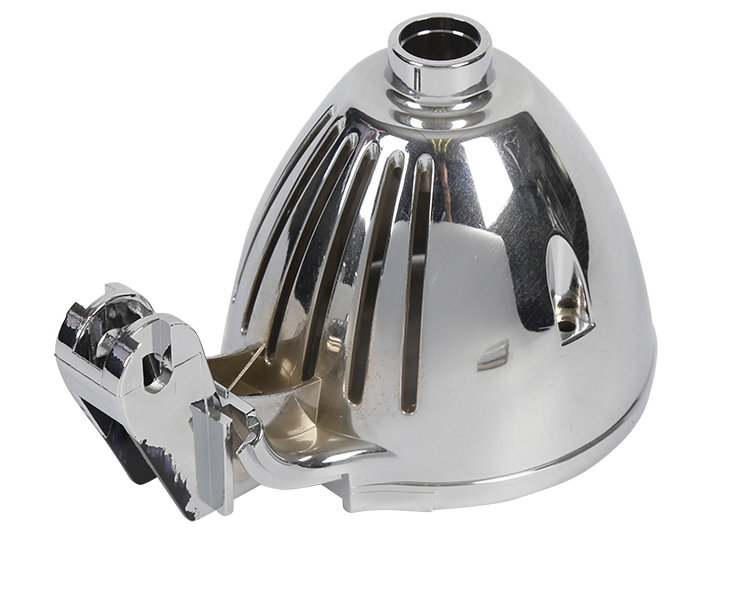At present, the chromium plating solution used in production is mainly hexavalent chromium solution. Hexavalent chromium is a substance that is very harmful to human beings. The pollution in chrome plating production is mainly the pollution of hexavalent chromium in cleaning water and exhaust gas. The methods to reduce pollution include the following aspects.
(1) Change the traditional chrome plating process
1) Decrease the concentration.
For the standard solution of Cr0, which is 2509/L, the content can be reduced to 180~2009/L without affecting the properties of the chromium layer. Reducing the content can reduce the chromic acid carried by the parts, reduce the burden of cleaning water treatment, and also reduce the content of chromium mist in the exhaust gas. The use of lower chromic acid content solutions also results in improved chrome plating current efficiency.
For the general decorative chromium process c, the content is 300~3509/L. When a rare-earth catalyst is used, the Cr0 content can be reduced to 120~2009/L, which can also reduce the chromium content in the discharged water and gas.
2) Lower the bath temperature.
The evaporation of chromic acid can be reduced, and the content of chromium mist in the exhaust air can also be greatly reduced, thereby reducing air pollution. Such as the use of rare-earth additives for decorative chromium, the process temperature can be reduced from 40 to 50 ° C to 20 to 35 ° C.
3) Select a suitable catalyst.
Generally, the current efficiency of chrome plating is low. The way to increase the deposition rate is to increase the current density. This method will lead to aggravated hydrogen evolution and increase the chromium mist in the exhaust air.
If composite chromium plating and rare earth chromium plating additives are used, a chromium layer of the same thickness can be obtained at the same time, and a lower current can be used due to the improved current efficiency. Therefore, hydrogen evolution is greatly reduced, thereby reducing the emission of chromium mist.
(2) Reducing the number of parts carried. Reducing the number of parts carried out is an effective way to reduce the concentration of cleaning water and reduce water pollution.
The simplest and most reliable way to reduce the number of parts carried is to stop the dripping after the parts are brought out of the solution. Staying for 8-10s can reduce the solution attached to the parts, and the drippings are all concentrated solutions. Thus, the burden of the next washing is reduced. A reasonable way of mounting and hanging parts is adopted, so that all or most of the solution carried in the parts can drip out in the dripping liquid.
(3) Adoption of recovery and countercurrent cleaning. Generally, five-stage recovery or countercurrent cleaning is set up after chrome plating.
After the fifth-grade water washing, the hexavalent chromium content in the fifth-grade water will reach 50~100mg/L. The chromic acid concentration in the cleaning water tank closer to the plating tank is higher, and the chromic acid content in the cleaning water tank farther from the plating tank decreases sequentially. When working, the plating tank needs to be replenished frequently, and the cleaning water with the highest content of the first level can be replenished at this time. The purpose of replenishing water can be achieved, and a large amount of chromic acid can be recovered. The other four levels are supplemented forward in turn, and only pure water needs to be supplemented in the last level. When the shape of the part is simple, no drainage is required, and even if it is drained, it is easy-to-treat wastewater with low and stable chromic acid content.
(4) The exhaust air of recycled chrome mist contains a large amount of chromic acid. A chrome mist collector can be installed behind the exhaust hood of the plating tank. By slowing down the wind speed, the chrome mist can be deposited on the net of the collector and washed with water regularly, which can be directly recovered. plating tank.
If you are afraid of contaminating the plating solution or accumulating impurities, this part of chromic acid can also be directly applied to the passivation of galvanizing. In the air duct between the edge hoods, it is difficult to recycle, and it is easy to cause new pollution.
For decorative chrome plating, chrome fog can be used to suppress wattle and reduce chrome fog overflow. However, due to the large thickness of hard chrome plating, the parts are prone to pitting at the solution interface and affect the quality, so chrome mist inhibitors cannot be used.
(5) Using trivalent chrome plating
Trivalent chrome plating has made great progress, and its color is very close to hexavalent chrome plating. It has been widely used in decorative chrome plating, and there are mature processes sold in the market. This is a realistic way to solve pollution.
(6) Using Substitute Chrome Plating Instead
For example, tin-cobalt-zinc alloy, but the gap in wear resistance limits its promotion.

